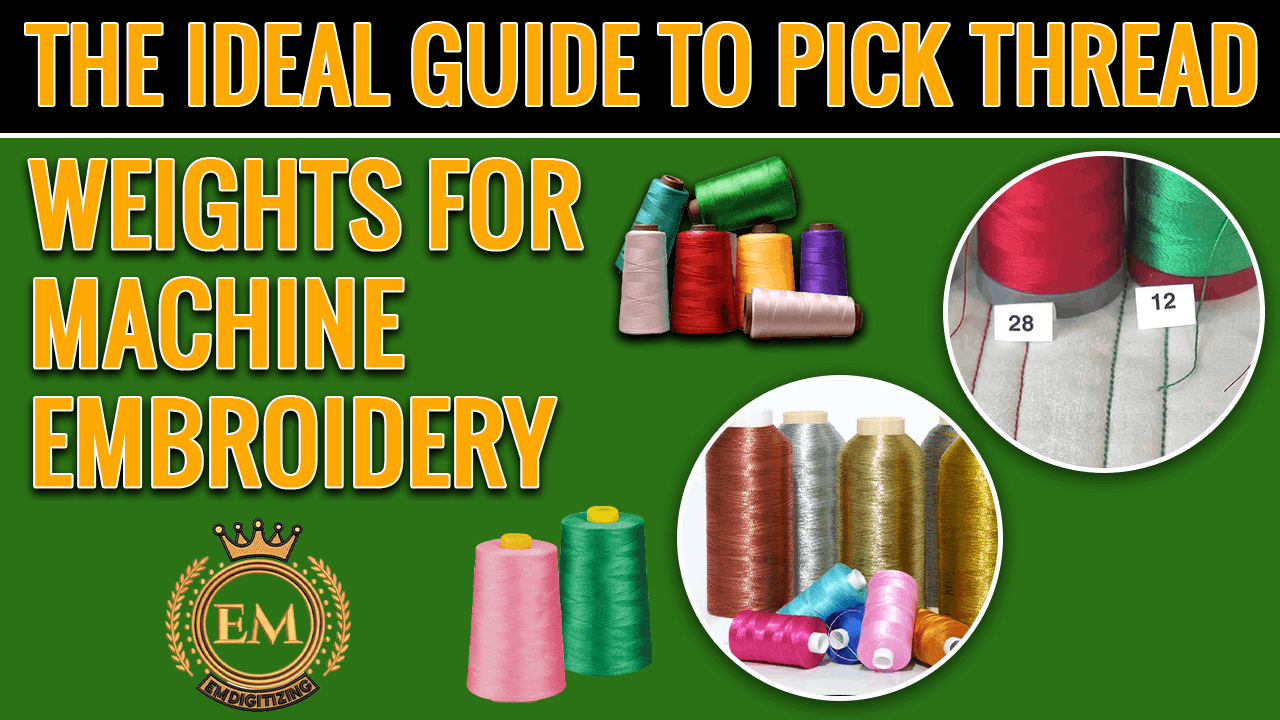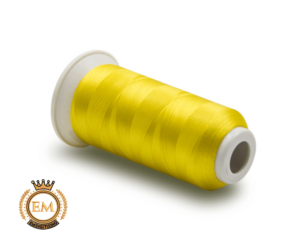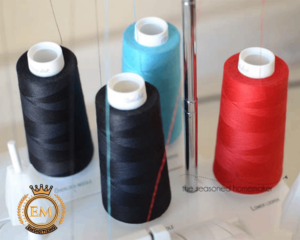La broderie à la machine est intéressante, mais accablant pour un nouveau venu. Les débutants ont tendance à ignorer l'importance de comprendre les différents types de fils de broderie machine et les poids des fils..

Services de numérisation de broderie
Vous êtes ici parce que vous souhaitez en savoir plus sur les épaisseurs de fil, leurs types, et tout. Bien, Vous êtes au bon endroit! Dans cet article, nous couvrirons le polyester, coton, soie, rayonne, et poids de fil pour broderie à la machine.
Avant de passer aux poids des fils, il est important de comprendre que tous les sujets ne sont pas similaires, et toutes les machines ne sont pas identiques. Faire correspondre la marque de fil à la machine et à l'aiguille, c'est comme trouver la meilleure recette. Peu de types et de marques de fils fonctionneront mieux avec des machines et des aiguilles spécifiques.
Il est essentiel de tester votre fil sur un morceau de tissu d'abord plutôt que sur votre chemise préférée.. Assurez-vous que le tissu sur lequel vous testerez est le même que le matériau que vous utiliserez pour votre projet. Commandez d'abord une petite quantité de fil pour des tests appropriés afin de voir ce qui fonctionne le mieux avec votre machine et votre cible créative..
Fils à broder en polyester:

Un fil de polyester est solide, grand teint, durable, et peut même résister à l'eau de Javel. Le fil de polyester donne une brillance qui donne à votre broderie un aspect professionnel.. Ce fil est disponible dans une vaste gamme de couleurs et est connu pour fonctionner sans problème.
C'est un choix incroyable pour la broderie générale, en particulier les vêtements d'extérieur ou les vêtements pour enfants. Nous savons tous que les enfants sont des petits anges sans gâchis, mais quand ils font des dégâts, le polyester résistera au processus de nettoyage.
La dernière chose qu'une machine souhaite, c'est un fil qui se casse constamment.. Votre machine serait heureuse d'utiliser du fil de polyester dans vos projets. Parce que les fils de polyester ont tendance à durer longtemps et ne se cassent pas facilement par rapport aux autres fils, ce qui permet à une machine de fonctionner de manière fluide et efficace.. Mais, un fil polyester ne doit pas être utilisé pour tous vos projets.
Fils à broder en rayonne:

Rayonne broderie à la machine les fils sont un choix courant car il s'agit d'une sélection étonnante de couleurs, encore plus que le polyester. Son seul point faible est sa solidité par rapport au polyester. Le polyester a un point de rupture bien plus élevé que la rayonne. C'est pourquoi il est important de tester différentes marques de fils de rayonne avec votre machine pour voir comment ils résistent aux travaux intensifs en points. motifs de broderie et couture à grande vitesse.
Le fil de rayonne fonctionne bien lors des coutures à vitesse élevée. Il est plus doux que le polyester et convient mieux aux travaux complexes ou aux travaux avec de la dentelle autoportante..
Fils à broder en coton:

Où le polyester et la rayonne sont fiers de leur aspect brillant le plus élevé, le fil de coton a une belle brillance douce. Vous pouvez commander des fils de coton au fini mat pour booster encore plus votre créativité. Il fonctionne bien dans la plupart des machines, mais, il est bon de le tester pour s'assurer qu'il fonctionne correctement.
Les fils de coton peuvent être achetés en épaisseur standard, mais il en existe aussi des variétés extrêmement fines, adapté aux travaux complexes et délicats. N'oubliez jamais que plus le fil est fin, plus il risque de se casser pendant la broderie.
Fils à broder en soie:

La soie est riche et recherchée dans l'industrie de la mode, et est considéré comme tout aussi riche en matière de broderie machine. Le fil de soie est solide et fin, mais a une brillance et une douceur incomparables avec la rayonne et le polyester..
Pour ces raisons, le fil de soie pourrait être cher, et ça pourrait être difficile d'obtenir des couleurs particulières. C'est le fil que vous voudriez utiliser pour des projets haut de gamme ou pour broder sur des matériaux de luxe..
Fils à broder métalliques:

Les fils métalliques sont réputés pour se casser lors de la broderie, ce qui pourrait provoquer de la frustration. Les fils métalliques donnent de belles couleurs et une brillance que d'autres fils ne peuvent pas imiter., mais beaucoup de nouveaux brodeurs sont très frustrés car réenfiler votre machine peut être un processus extrêmement irritant et long..
Ce problème pourrait être simplement résolu avec plusieurs ajustements à votre méthode de bobinage et en assurant l'utilisation d'une aiguille spécifique aux métaux. fil à broder.
Ils sont composés d’un noyau central enveloppé de métaux ou de feuilles puis teint avec la couleur désirée.. Ces brins ont tendance à s'effondrer simplement, c'est là que l'intégrité du thread semble échouer. Choisir des fils métalliques de la plus haute qualité réduira la casse lors de la broderie, et valent le centime supplémentaire.
Une brève leçon sur les poids des fils à broder à la machine:

Voyons où vous pouvez utiliser les poids de fil.
Votre fil standard sera souvent disponible dans un fil moyen de 40 wt et 50 Poids. Sujets. Mais une large gamme d'autres fils existe en poids 100 super fin., ou des options super épaisses à trois poids également.
Cousez comme un pro lorsque vous savez comment le poids du fil influence vos points.. Que vous souhaitiez que le fil se fonde dans la masse ou scintille et se mette en valeur, sélectionner le bon fil ferait toute la différence dans vos projets de broderie.
Poids de fil moyen:

Les fils de poids moyen sont les types de fils que vous trouverez le plus souvent, le plus souvent du fil de 40 poids et 50 Poids. Sujets. Ils peuvent être utilisés pour le quilting, construction, broderie à la machine, Surjeteuses, et couture à usage général.
Les fils de poids moyen sont fabriqués à partir de tous types de matériaux, y compris le coton., rayonne, polyester, et même métallique.
Ce poids de fil se mélangera ou apparaîtra en fonction de la composition du tissu.. Ainsi, le coton se mélangera plus qu'une volonté métallique. Mais si vous ne voulez pas que votre fil s'affiche, vous devrez peut-être envisager un poids différent.
Poids de fil fin:

Fils fins allant de 60wt à 100wt. Ces petits fils sont parfaits pour les travaux complexes comme le micro quilting et la broderie machine finement détaillée comme les motifs de broderie autoportants ou les monogrammes..
Ils peuvent être fabriqués à partir de coton pour la partie la plus grande et de polyester pour la partie la plus fine.. Les fils fins se mélangent mieux et prennent moins de place, ils sont donc parfaits pour les applications à la main et à la machine, assemblage de papier anglais, et micro matelassage.
Un matelassage dense rendrait également les couettes plus douces, plus flexible, et plus léger car le fil ne prend pas autant de place et n'ajoute pas autant de poids.
Cette 80 Le fil de polyester en poids s'appelle DecoBob et est considéré comme le fil d'assemblage et de canette préféré.. Parce que c'est si bien, cela rend les coutures plus plates et plus nettes lors de l'assemblage. Ceci est particulièrement utile lorsqu'il s'agit d'assembler du papier de base ou lorsque vous souhaitez faire correspondre avec précision des motifs et des blocs.. C'est aussi incroyablement fort, ce qui en fait un choix fiable pour maintenir vos projets et courtepointes ensemble.
Comme fil de canette, c'est suprême. Le fil fin peut être associé à n'importe quel fil supérieur, y compris des fils plus épais.. Cela réduit étonnamment les problèmes de tension, permet à vos coutures d'être plus plates et d'avoir un aspect plus professionnel, et en prime, cela permet à votre canette de contenir plus de fil car le fil fin prend moins de place.
Poids de fil lourds:

Les fils épais diffèrent de 12 – 18 poids. 12les fils en poids peuvent toujours passer à travers le chas d'une aiguille de machine à coudre, vous pouvez donc réaliser des coutures étonnantes avec ce fil le plus épais, alors que les fils de 8 poids et plus ne sont pas suggérés comme fil supérieur..
Utilisez 12wt pour le quilting audacieux à la machine, quilting à la main en gros points, peinture au fil, broderie à la main, quilting à la main en gros points, coutures décoratives, et même ourler un jean.
Lorsque vous l'utilisez sur la machine, le fil plus épais se détachera du matériau, vous donnant un effet texturé étonnant..
8Les fils en poids et plus épais sont les plus couramment utilisés pour la broderie à la main.. Même s'ils sont très épais pour passer à travers l'aiguille de la machine à coudre, vous pouvez toujours travailler sur un canapé et une canette avec eux sur une machine ou l'utiliser dans les boucleurs d'une surjeteuse. Il peut également être utilisé pour des choses similaires à 12wt, en plus crocheter, et tricoter.
Liquidation:
C'était la fin de cet article. Nous espérons que vous comprenez maintenant les poids et les types de fils.. Nous espérons que vous avez apprécié la lecture de cet article comme nous l'avons fait par écrit.
Si vous souhaitez personnaliser la numérisation du logo de broderie, EM DIGITIZING sera votre meilleur choix. Chez EM DIGITIZING, nous livrons le meilleur logo de broderie services de numérisation avec la meilleure qualité. Nous offrons 50% de réduction sur tous nos services à nos clients potentiels lors de leur première commande. Alors, obtenez un devis gratuit maintenant et nous vous contacterons.
J'espère que cet article vous sera utile les gars!
Si vous avez des questions liées à cet article, n'hésitez pas à nous faire part de vos commentaires.. Et, Merci d'avoir lu!
Poids avec 40 sont considérés comme le fil le plus fin et le plus léger par rapport au 60wt. Plus le nombre est élevé, plus le fil est fin! 40le fil doit être votre fil de prédilection pour la broderie quotidienne.
Oui, un 30 le fil de poids est plus épais et plus lourd qu'un fil de poids 50 car il est plus dense et ne prend que trente km pour égaler un kg par rapport à 50. La fraction inscrite sur la bobine de fil vous indique le poids et le nombre de plis ou de brins torsadés ensemble..
28-les fils de poids sont le deuxième fil le plus lourd et sont parfaits pour le point de croix à double brin, point de feston, assemblage à la main, hand appliqué, piquage à la main, dentelle machine, et surjet en boucle inférieure.
40 les fils épais sont les fils à broder les plus couramment utilisés et couvrent la plupart des projets, de la broderie à main levée au quilting, numérisation, à la construction de vêtements.
Le fil de coton le plus utilisé dans la broderie à la main est le coton mouliné., également connu sous le nom de fil à broder. Le coton mouliné est livré en écheveaux, et tout le fil qui sort de l'écheveau est divisible en 6 séparé, fils fins.
